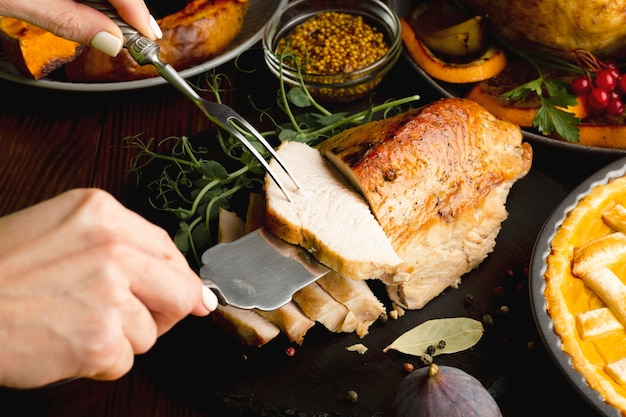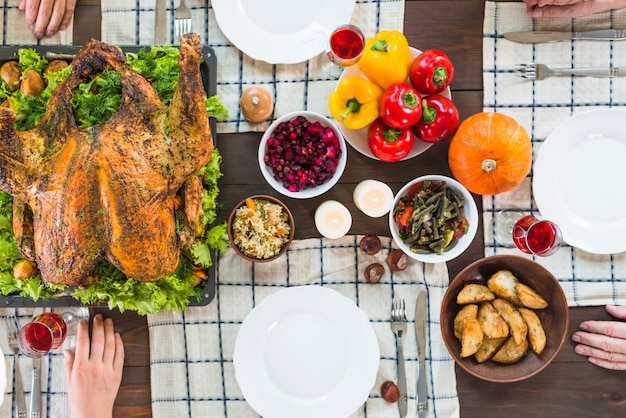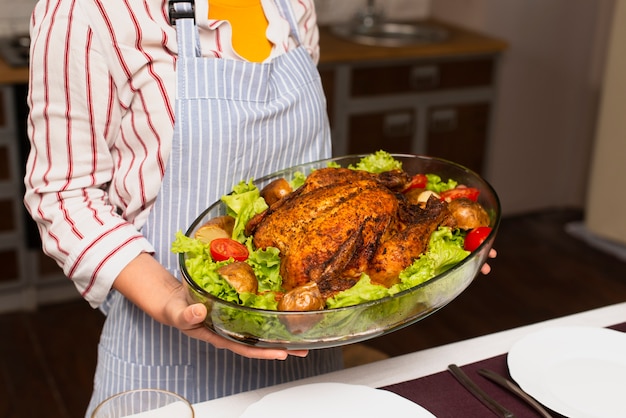Ah, the turkey. It's the star of the Christmas dinner show, the centerpiece of festive gatherings, and a symbol of good cheer. And for good reason - a perfectly cooked turkey is a thing of beauty: golden brown, juicy, and bursting with flavor. This year, I'm taking on a 13-pound behemoth, a real challenge, but one I'm eager to conquer. This guide is a culmination of years of experience, tips, and tricks I've picked up along the way, designed to help you achieve the same delicious results. So, grab your apron, settle in, and let's get cooking!
(Part 1) Choosing the Right Bird: A Feast for the Senses

The journey to a delicious turkey starts with the right bird. Don't just grab the first one you see at the supermarket - choosing your turkey requires a little more consideration. A 13-pounder is no small feat, and you want to make sure it's a quality bird, one that will bring a smile to everyone's face when it graces the table.
Free Range: The Flavor of Freedom
My first recommendation? Always opt for a free-range turkey if you can. It's a bit more expensive, sure, but the difference in flavor is absolutely noticeable. You're getting a bird that has had a happier life, roaming freely and enjoying fresh air and sunshine. The result is a richer, more flavorful turkey that simply sings with deliciousness. Plus, you'll be doing your part for animal welfare, which is always a good feeling.
Size Matters: Planning for Your Party
Now, a 13-pound turkey is a substantial bird, perfectly suited for a gathering of 10-12 people, maybe even more if you're planning a feast with a mountain of side dishes. I generally recommend about 1 pound per person, but this can vary depending on your guests' appetites. Remember, it's Christmas dinner, so a bit of extra indulgence is always welcomed!
Beyond the Basics: Exploring Different Breeds
While a standard bronze turkey is a classic choice, consider venturing into other breeds for a truly unique experience. A heritage breed like a Bourbon Red or a Broad Breasted White will offer a slightly different flavor profile and texture. It's a great opportunity to expand your culinary horizons and impress your guests with your knowledge of turkeys beyond the ordinary.
(Part 2) Prepping Your Turkey: Getting Ready for the Roast

Once you've got your prized turkey home, it's time for a little prep work. Don't be intimidated, this isn't a complicated process, but it's vital for ensuring a perfectly cooked and flavorful bird.
Cleaning House: Removing the Innards
The first step is removing the giblets and neck from the cavity. These are often packaged inside the turkey, sometimes in a small bag. Don't throw them away! These are the ingredients for a delicious homemade turkey stock, which adds a wonderful depth of flavor to your gravy or soup later on.
Patting It Dry: The Key to crispy skin
Now, pat the turkey dry inside and out using paper towels. This is important for achieving that beautiful, crispy skin we all crave. A damp turkey will steam in the oven, resulting in a soggy, less-than-desirable outcome. A little bit of dryness goes a long way!
Seasoning the Bird: The Flavor Foundation
Here comes the fun part - seasoning your turkey. I'm a big fan of simplicity when it comes to seasoning. A good blend of salt, pepper, and herbs like rosemary, thyme, and sage works wonders. The key is to season generously, both inside and out, to ensure every part of the turkey is infused with flavour.
Stuffing Secrets: A Delicious Debate
Stuffing is a personal preference. Some people swear by traditional sausage-based stuffing, while others prefer a bread-based stuffing with herbs and vegetables. I'm partial to a classic sage and onion stuffing, but I'm always up for experimenting with different flavors.
Remember, stuffing is a delicate dance. It should be loose and not packed too tightly into the turkey. This ensures even cooking and prevents soggy stuffing. Plus, you don't want to overstuff the bird to the point where it won't fit in the roasting pan!
(Part 3) Cooking Your Turkey: The Heart of the Feast

Finally, the moment of truth - cooking your turkey! This is where your patience and a little bit of know-how come into play. You want to make sure your turkey cooks through completely without drying out. Nobody wants a dry, rubbery turkey on Christmas Day, right?
Time and Temperature: The Golden Rule
So, how long does it take to cook a 13-pound turkey? It depends on a few factors, like your oven, how much stuffing you've used, and whether you're using a roasting rack. A good rule of thumb is to allow 20-25 minutes per pound at 325°F (160°C). But, remember, the real judge is a meat thermometer. The turkey is ready when the internal temperature reaches 165°F (74°C) in the thickest part of the thigh. This ensures the turkey is safe to eat and cooked to perfection.
roasting techniques: Classic and Modern
You have a few options when it comes to roasting. I'm a traditionalist, so I prefer roasting in a regular oven. A roasting rack is a must-have for elevating the turkey above the pan, allowing hot air to circulate around it for even cooking.
Don't forget to baste regularly with pan juices throughout the cooking process. This adds moisture and flavor, ensuring a juicy and succulent turkey. You can also use a turkey baster for this, or simply spoon the juices over the bird.
For a more hands-off approach, consider slow cooking your turkey. A 13-pound turkey will take around 6-8 hours on low heat in a slow cooker. It's a great option if you want to spend less time in the kitchen, but remember, you might not get the same crispy skin as with traditional roasting.
(Part 4) Resting Your Turkey: The Secret to Juiciness
Once your turkey is cooked, don't rush to carve it! Allow it to rest for at least 30 minutes, preferably an hour, before slicing. This is crucial for allowing the juices to redistribute throughout the bird, ensuring a moist and flavorful outcome. While the turkey is resting, get those side dishes ready, make some gravy, and savor the anticipation of a delicious feast.
(Part 5) Carving Your Turkey: The Art of the Slice
carving a turkey can seem intimidating, but it's actually quite simple with a little practice. It's a bit like a culinary performance, and the right tools and techniques will help you create a masterpiece.
Essential Equipment: Your Carving Arsenal
First, gather your tools. You'll need a sharp carving knife, a carving fork, and a cutting board. I prefer a carving knife specifically designed for poultry, with a long, thin blade for precise cuts without tearing the meat.
Step-by-Step Carving: A Visual Guide
Here's a step-by-step guide to carving your turkey with confidence:
- Remove the wings: Start by cutting the wings off at the joint.
- Carve the breast: Use your carving knife to slice the breast meat in thin slices. I like to carve the breast into two halves, then slice each half into individual pieces.
- Remove the legs: Next, use your carving knife to cut the legs off at the joint.
- Carve the thighs: Separate the thigh from the drumstick at the joint, and carve the thigh into individual slices. You can also use your carving knife to remove the skin from the thigh before carving.
- Carve the drumsticks: Carve the drumsticks into individual pieces.
(Part 6) Leftover Turkey Goodness: Beyond the Feast
Christmas dinner is over, and you're left with a mountain of delicious leftover turkey. Don't despair! This is where the real culinary creativity begins. Leftover turkey is a treasure trove of flavour, ready to be transformed into new and delicious dishes.
turkey sandwiches: A Classic Reimagined
A classic for a reason, leftover turkey sandwiches are a delicious and satisfying way to use up your turkey. Slice up some turkey, add a bit of stuffing, cranberry sauce, and a dollop of mayonnaise. You can even add a slice of cheese or some crispy bacon for an extra dose of flavor.
turkey soup: A Hearty and Comforting Treat
Soup is a fantastic way to use up leftover turkey, especially during colder months. I like to make a simple turkey and vegetable soup with carrots, celery, and potatoes. You can add other vegetables you have on hand, such as onions, mushrooms, or leeks. Don't forget to add some herbs and spices like thyme, parsley, and black pepper for extra flavor.
turkey pot pie: A Savory and Satisfying Pie
For a more substantial meal, try making a turkey pot pie. This is a perfect way to use up leftover turkey, gravy, and vegetables. You can use a store-bought pie crust, or make your own from scratch. I prefer a flaky, buttery pie crust for my turkey pot pies.
Turkey Shepherd's Pie: A Hearty and Comforting Classic
For a twist on a classic, create a delicious turkey shepherd's pie. Layer leftover turkey with mashed potatoes, vegetables, and a rich gravy for a hearty and comforting meal. You can even add some cheese on top for a cheesy, gooey finish.
(Part 7) Cooking Time Tips: Mastering the Art of turkey roasting
I've been cooking turkeys for years, and I've learned a few tips along the way that can make a big difference in your turkey's outcome. Here are some of my favourite tips for getting the perfect roast turkey every time.
- Don't overstuff the turkey. Overstuffing the turkey can prevent it from cooking evenly and can lead to soggy stuffing. Leave some space for the stuffing to cook properly.
- Use a meat thermometer. This is essential for ensuring that the turkey is cooked through. A meat thermometer is a great investment if you don't already have one.
- Baste the turkey regularly. Basting the turkey with pan juices helps to keep it moist and flavorful. You can also use a turkey baster for this, or simply spoon the juices over the bird.
- Let the turkey rest. This is crucial for allowing the juices to redistribute throughout the bird. Patience is key!
- Don't be afraid to experiment. Try different seasonings, stuffing recipes, and cooking methods to find what works best for you. Embrace the joy of culinary exploration!
(Part 8) turkey cooking time chart: A Handy Guide
Here's a handy chart that you can use to estimate the cooking time for your 13-pound turkey:
| turkey weight (lbs) | Cooking Time (mins) |
|---|---|
| 10-12 | 200-240 |
| 12-14 | 240-280 |
| 14-16 | 280-320 |
Remember, these are just estimates. It's always best to use a meat thermometer to check for doneness. And don't be afraid to adjust the cooking time based on your oven and the size of your turkey.
(Part 9) FAQs: Your Turkey Cooking Questions Answered
1. What is the best way to thaw a frozen turkey?
The safest and most effective way to thaw a frozen turkey is in the refrigerator. Allow 24 hours for every 5 pounds of turkey to thaw. For example, a 13-pound turkey will take about 65 hours to thaw in the refrigerator. Plan ahead!
You can also thaw your turkey in cold water. Place the turkey in a leak-proof bag and submerge it in cold water. Change the water every 30 minutes. A 13-pound turkey should thaw in cold water in about 3-4 hours. This is a faster method, but make sure to keep the water cold to prevent bacterial growth.
2. Can I cook a turkey in a slow cooker?
Yes, you can cook a turkey in a slow cooker. However, you may not get the same crispy skin as you would with traditional roasting. It's best to use a boneless turkey breast for slow cooking, as it will cook more evenly. Follow the manufacturer's instructions for cooking time and temperature.
3. What is the best way to store leftover turkey?
Store leftover turkey in an airtight container in the refrigerator for up to 3-4 days. You can also freeze leftover turkey for up to 2-3 months. Thaw frozen turkey in the refrigerator before using.
4. What are some good side dishes to serve with turkey?
There are endless possibilities for side dishes to serve with turkey. Some popular options include mashed potatoes, stuffing, gravy, cranberry sauce, green beans, sweet potatoes, and cornbread. You can also serve a variety of salads, such as coleslaw, potato salad, and fruit salad. Consider the flavors and textures that will complement your turkey and create a well-balanced meal.
5. What are some tips for making a delicious gravy?
Make sure to use pan drippings from the turkey to give your gravy a rich, flavorful base. You can also add some butter, flour, and herbs to your gravy for extra flavour. Simmer the gravy over low heat until it thickens. And don't forget to strain the gravy before serving to remove any lumps or bits of food.
There you have it! With these tips and tricks, you'll be a turkey cooking pro in no time. So, gather your ingredients, fire up your oven, and get ready for a delicious Christmas dinner! Happy Holidays!
Everyone is watching

Prime Rib Roast Cooking Time Chart: Per Pound Guide
Cooking TipsPrime rib roast. Just the name conjures images of lavish dinners, crackling fires, and hearty laughter. It’s ...

How Long to Bake Potatoes in the Oven (Perfect Every Time)
Cooking TipsBaked potatoes are a staple in my kitchen. They're incredibly versatile, delicious, and surprisingly easy to m...

Perfect Rice Every Time: The Ultimate Guide to Cooking Rice
Cooking TipsAs a self-proclaimed foodie, I've always been a bit obsessed with rice. It's the foundation of countless cuisi...

The Ultimate Guide to Cooking Asparagus: Tips, Techniques, and Recipes
Cooking TipsAsparagus. The mere mention of this spring delicacy conjures up images of vibrant green spears, crisp and burs...

Ultimate Guide to Cooking the Perfect Thanksgiving Turkey
Cooking TipsThanksgiving. Just the word conjures up images of overflowing tables laden with delicious food, the scent of r...
